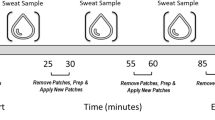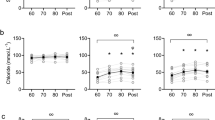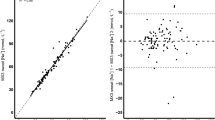Abstract
Purpose
This study aimed to quantify the relationship between venous and capillary blood sampling methods for the measurement of plasma interleukin-6 (IL-6). A parallel study was conducted to determine the possibility of measuring IL-6 in sweat using an enzyme-linked immunosorbent assay (ELISA) and investigate the relationship between plasma- and sweat-derived measures of IL-6.
Methods
Twelve male participants were recruited for the measurement of IL-6 at rest and during exercise (study 1). An additional group of five female participants was recruited for the measurement of IL-6 in venous blood versus sweat at rest and following exercise (study 2). In study 1, venous and capillary blood samples were collected at rest and in response to exercise. In study 2, venous and sweat samples were collected following exercise.
Results
Mean plasma IL-6 concentration was not different between venous and capillary blood sampling methods either at rest (4.27 ± 5.40 vs. 4.14 ± 4.45 pg ml−1), during (5.40 ± 5.17 vs. 5.58 ± 6.34 pg ml−1), or in response to exercise (6.95 ± 6.37 vs. 6.99 ± 6.74 pg ml−1). There was no IL-6 detectable in sweat either at rest or following exercise.
Conclusion
There are no differences in the measurement of plasma IL-6 using either venous or capillary blood sampling methods. Capillary measurement represents a minimally invasive way of measuring IL-6 and detecting changes in IL-6, which are linked to fatigue and overtraining.




Similar content being viewed by others
Abbreviations
- ANOVA:
-
Analysis of variance
- ELISA:
-
Enzyme-linked immunosorbent assay
- IL-6:
-
Interleukin-6
- MID:
-
Mid-exercise
- POST:
-
Post-exercise
- PRE:
-
Pre-exercise
- PRE (2):
-
Repeated pre-exercise
- rhIL-6:
-
Recombinant IL-6
- \(\dot{V}{\text{O}}_{{ 2 {\text{peak}}}}\) :
-
Peak oxygen consumption
References
Baechle D, Flad T, Cansier A et al (2006) Cathepsin D is present in human eccrine sweat and involved in the postsecretory processing of the antimicrobial peptide DCD-1L. J Biol Chem 281:5406–5415. doi:10.1074/jbc.M504670200
Bland JM, Altman DG (1986) Statistical methods for assessing agreement between two methods of clinical measurement. Lancet 1(8476):307–310
Boysen TC, Yanagawa S, Sato F, Sato K (1984) A modified anaerobic method of sweat collection. J Appl Physiol Respir Environ Exerc Physiol 56:1302–1307
Brisson GR, Boisvert P, Peronnet F, Perrault H, Boisvert D, Lafond JS (1991) A simple and disposable sweat collector. Eur J Appl Physiol Occup Physiol 63:269–272
Bruunsgaard H (2005) Physical activity and modulation of systemic low-level inflammation. J Leukoc Biol 78:819–835. doi:10.1189/jlb.0505247
Ceperuelo-Mallafré V, Näf S, Escoté X et al (2009) Circulating and adipose tissue gene expression of Zinc-α2-glycoprotein in obesity: its relationship with adipokine and lipolytic gene markers in subcutaneous and visceral fat. J Clin Endocrinol Metab 94:5062–5069. doi:10.1210/jc.2009-0764
Christiansen T, Bruun JM, Paulsen SK et al (2013) Acute exercise increases circulating inflammatory markers in overweight and obese compared with lean subjects. Eur J Appl Physiol 113:1635–1642. doi:10.1007/s00421-013-2592-010.1007/s00421-013-2592-0
Cizza G, Marques AH, Eskandari F et al (2008) Elevated neuroimmune biomarkers in sweat patches and plasma of premenopausal women with major depressive disorder in remission: the POWER Study. Biol Psychiatry 64:907–911. doi:10.1016/j.biopsych.2008.05.035
Cohen JW (1988) Statistical power analysis for the behavioural sciences, 2nd edn. Lawrence Erlbaum Associates, Hillside, NJ
Cox A, Pyne D, Gleson M, Callister R (2008) Resting plasma and salivary IL-6 concentrations are not correlated in distance runners. Eur J Appl Physiol 103:477–479. doi:10.1007/s00421-008-0722-x
Dai X, Okazaki H, Hanakawa Y et al (2013) Eccrine Sweat Contains IL-1Î ± , IL-1Î2 and IL-31 and activates epidermal keratinocytes as a danger signal. PLoS One 8:e67666
Dill DB, Costill DL (1974) Calculation of percentage changes in volumes of blood, plasma, and red cells in dehydration. J Appl Physiol 37:247–248
Dubois V, Delort L, Mishellany F et al (2010) Zinc-a2-glycoprotein: a new biomarker of breast cancer? Anticancer Res 30:2919–2925
Eriksson M, Sartono E, Martins CL et al (2007) A comparison of ex vivo cytokine production in venous and capillary blood. Clin Exp Immunol 150:469–476. doi:10.1111/j.1365-2249.2007.03515.x
Febbraio MA, Pedersen BK (2002) Muscle-derived interleukin-6: mechanisms for activation and possible biological roles. FASEB J 16:1335–1347. doi:10.1096/fj.01-0876rev
Fischer CP (2006) Interleukin-6 in acute exercise and training: what is the biological relevance? Exerc Immunol Rev 12:6–33
Gallen IW, Macdonald IA (1990) Effect of two methods of hand heating on body temperature, forearm blood flow, and deep venous oxygen saturation. Am J Physiol 259:E639–E643
Gray SR, Robinson M, Nimmo MA (2008) Response of plasma IL-6 and its soluble receptors during submaximal exercise to fatigue in sedentary middle-aged men. Cell Stress Chaperones 13:247–251. doi:10.1007/s12192-008-0019-310.1007/s12192-008-0019-3
Grellner W (2002) Time-dependent immunohistochemical detection of proinflammatory cytokines (IL-1beta, IL-6, TNF-alpha) in human skin wounds. Forensic Sci Int 130:90–96
Hassan MI, Waheed A, Yadav S, Singh TP, Ahmad F (2008) Zinc α2-Glycoprotein: a multidisciplinary protein. Mol Cancer Res 6:892–906. doi:10.1158/1541-7786.MCR-07-2195
Horie N, Yokozeki H, Sato K (1986) Proteolytic enzymes in human eccrine sweat: a screening study. Am J Physiol 250:R691–R698
Leggate M, Nowell MA, Jones SA, Nimmo MA (2010) The response of interleukin-6 and soluble interleukin-6 receptor isoforms following intermittent high intensity and continuous moderate intensity cycling. Cell Stress Chaperones 15:827–833. doi:10.1007/s12192-010-0192-z
Lobley GE, Holtrop G, Bremner DM, Calder AG, Milne E, Johnstone AM (2013) Impact of short term consumption of diets high in either non-starch polysaccharides or resistant starch in comparison with moderate weight loss on indices of insulin sensitivity in subjects with metabolic syndrome. Nutrients 5:2144–2172. doi:10.3390/nu5062144
Mark H, Harding CR (2013) Amino acid composition, including key derivatives of eccrine sweat: potential biomarkers of certain atopic skin conditions. Int J Cosmet Sci 35:163–168. doi:10.1111/ics.12019
Marques-Deak A, Cizza G, Eskandari F et al (2006) Measurement of cytokines in sweat patches and plasma in healthy women: validation in a controlled study. J Immunol Methods 315:99–109. doi:10.1016/j.jim.2006.07.011
Midander K, Pan J, Wallinder IO, Heim K, Leygraf C (2007) Nickel release from nickel particles in artificial sweat. Contact Dermat 56:325–330. doi:10.1111/j.1600-0536.2007.01115.x
Minetto M, Rainoldi A, Gazzoni M et al (2005) Differential responses of serum and salivary interleukin-6 to acute strenuous exercise. Eur J Appl Physiol 93:679–686. doi:10.1007/s00421-004-1241-z
Minetto MA, Gazzoni M, Lanfranco F et al (2007) Influence of the sample collection method on salivary interleukin-6 levels in resting and post-exercise conditions. Eur J Appl Physiol 101:249–256. doi:10.1007/s00421-007-0484-x
Mracek T, Stephens NA, Gao D et al (2011) Enhanced ZAG production by subcutaneous adipose tissue is linked to weight loss in gastrointestinal cancer patients. Br J Cancer 104:441–447
Park JH, Park GT, Cho IH, Sim SM, Yang JM, Lee DY (2011) An antimicrobial protein, lactoferrin exists in the sweat: proteomic analysis of sweat. Exp Dermatol 20:369–371. doi:10.1111/j.1600-0625.2010.01218.x
Raison CL, Capuron L, Miller AH (2006) Cytokines sing the blues: inflammation and the pathogenesis of depression. Trends Immunol 27:24–31
Raiszadeh MM, Ross MM, Russo PS et al (2012) Proteomic analysis of eccrine sweat: implications for the discovery of schizophrenia biomarker proteins. J Proteome Res 11:2127–2139. doi:10.1021/pr2007957
Robson-Ansley PJ, de Milander L, Collins M, Noakes TD (2004) Acute interleukin-6 administration impairs athletic performance in healthy, trained male runners. Can J Appl Physiol 29:411–418
Rydén M, Agustsson T, Andersson J, Bolinder J, Toft E, Arner P (2012) Adipose zinc-?2-glycoprotein is a catabolic marker in cancer and noncancerous states. J Intern Med 271:414–420. doi:10.1111/j.1365-2796.2011.02441.x
Sarno M, Sarno L, Baylink D et al (2001) Excretion of sweat and urine pyridinoline crosslinks in healthy controls and subjects with established metabolic bone disease. Clin Chem Lab Med 39:223–228. doi:10.1515/CCLM.2001.035
Spath-Schwalbe E, Hansen K, Schmidt F et al (1998) Acute effects of recombinant human interleukin-6 on endocrine and central nervous sleep functions in healthy men. J Clin Endocrinol Metab 83:1573–1579
Stephens FB, Roig M, Armstrong G, Greenhaff PL (2008) Post-exercise ingestion of a unique, high molecular weight glucose polymer solution improves performance during a subsequent bout of cycling exercise. J Sports Sci 26:149–154. doi:10.1080/02640410701361548
Tian YW, Stacey MC (2003) Cytokines and growth factors in keratinocytes and sweat glands in chronic venous leg ulcers. An immunohistochemical study. Wound Repair Regen 11:316–325
Wang X, Bao W, Liu J et al (2013) Inflammatory markers and risk of Type 2 diabetes: a systematic review and meta-analysis. Diabetes Care 36:166–175. doi:10.2337/dc12-0702
Yang M, Liu R, Li S et al (2013) Zinc-a2-glycoprotein is associated with insulin resistance in humans and is regulated by hyperglycemia, hyperinsulinemia, or liraglutide administration: cross-sectional and interventional studies in normal subjects, insulin-resistant subjects, and subjects with newly diagnosed diabetes. Diabetes Care 36:1074–1082. doi:10.2337/dc12-0940
Acknowledgments
The research was supported by the National Institute for Health Research (NIHR) Diet, Lifestyle & Physical Activity Biomedical Research Unit based at University Hospitals of Leicester and Loughborough University. The views expressed are those of the authors and not necessarily those of the NHS, the NIHR or the Department of Health. The authors were fully responsible for conducting the trial and analysing the data.
Author information
Authors and Affiliations
Corresponding author
Additional information
Communicated by Fabio Fischetti.
Rights and permissions
About this article
Cite this article
Faulkner, S.H., Spilsbury, K.L., Harvey, J. et al. The detection and measurement of interleukin-6 in venous and capillary blood samples, and in sweat collected at rest and during exercise. Eur J Appl Physiol 114, 1207–1216 (2014). https://doi.org/10.1007/s00421-014-2851-8
Received:
Accepted:
Published:
Issue Date:
DOI: https://doi.org/10.1007/s00421-014-2851-8




